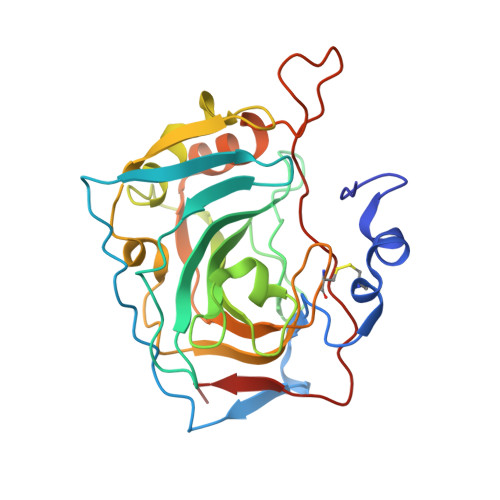Crystal structure of the dimeric extracellular domain of human carbonic anhydrase XII, a bitopic membrane protein overexpressed in certain cancer tumor cells.
Whittington, D.A., Waheed, A., Ulmasov, B., Shah, G.N., Grubb, J.H., Sly, W.S., Christianson, D.W.(2001) Proc Natl Acad Sci U S A 98: 9545-9550
- PubMed: 11493685
- DOI: https://doi.org/10.1073/pnas.161301298
- Primary Citation of Related Structures:
1JCZ, 1JD0 - PubMed Abstract:
Overexpression of the zinc enzyme carbonic anhydrase (CA; EC ) XII is observed in certain human cancers. This bitopic membrane protein contains an N-terminal extracellular catalytic domain, a membrane-spanning alpha-helix, and a small intracellular C-terminal domain. We have determined the three-dimensional structure of the extracellular catalytic domain of human CA XII by x-ray crystallographic methods at 1.55-A resolution. The structure reveals a prototypical CA fold; however, two CA XII domains associate to form an isologous dimer, an observation that is confirmed by studies of the enzyme in solution. The identification of signature GXXXG and GXXXS motifs in the transmembrane sequence that facilitate helix-helix association is additionally consistent with dimeric architecture. The dimer interface is situated so that the active site clefts of each monomer are clearly exposed on one face of the dimer, and the C termini are located together on the opposite face of the dimer to facilitate membrane interaction. The amino acid composition of the active-site cleft closely resembles that of the other CA isozymes in the immediate vicinity of the catalytic zinc ion, but differs in the region of the nearby alpha-helical "130's segment." The structure of the CA XII-acetazolamide complex is also reported at 1.50-A resolution, and prospects for the design of CA XII-specific inhibitors of possible chemotherapeutic value are discussed.
- Roy and Diana Vagelos Laboratories, Department of Chemistry, University of Pennsylvania, Philadelphia, PA 19104-6323, USA.
Organizational Affiliation:


















